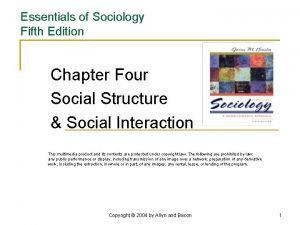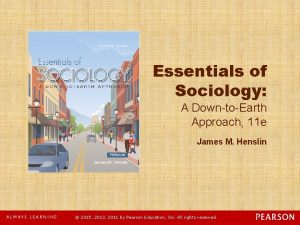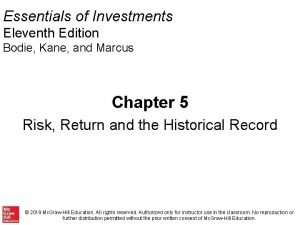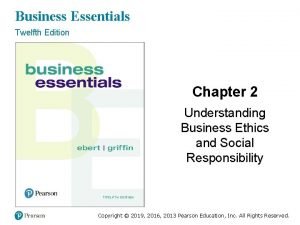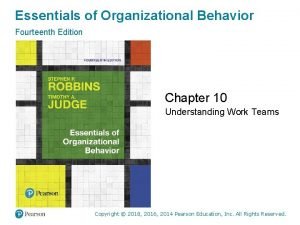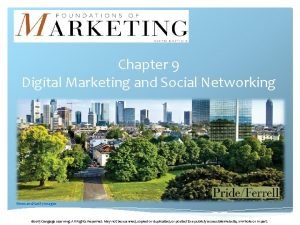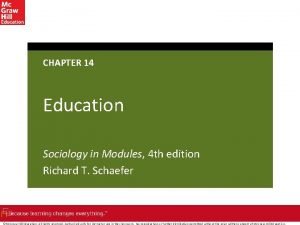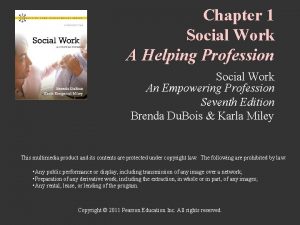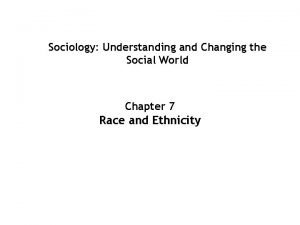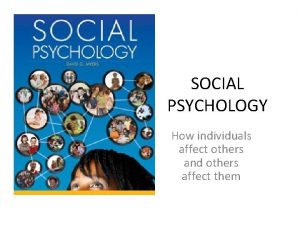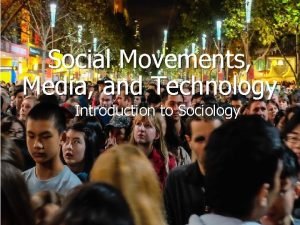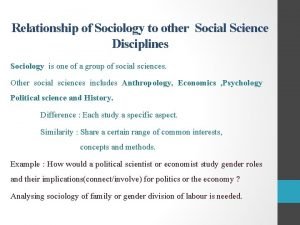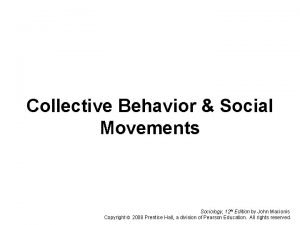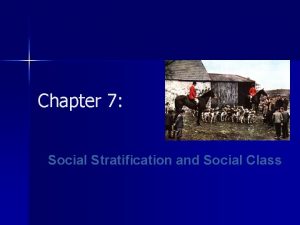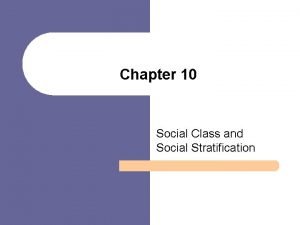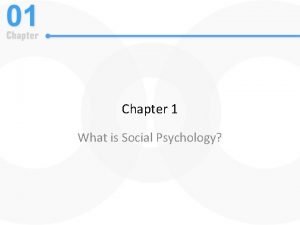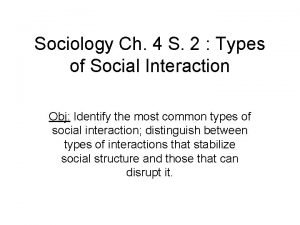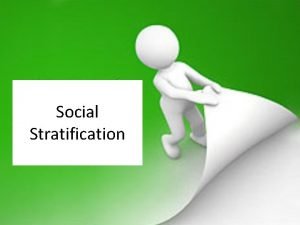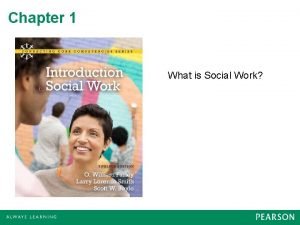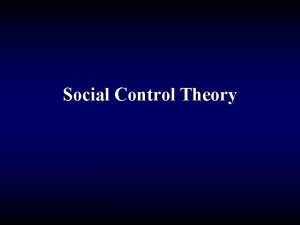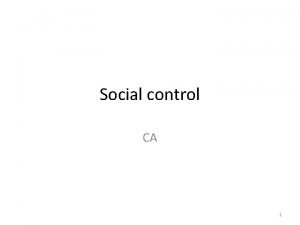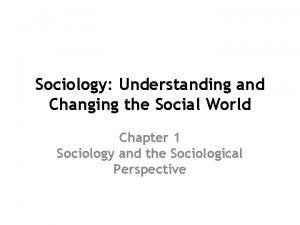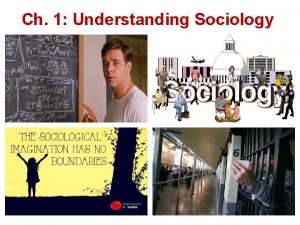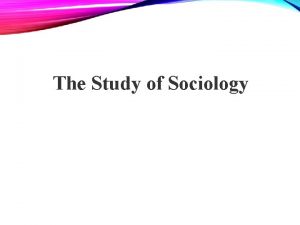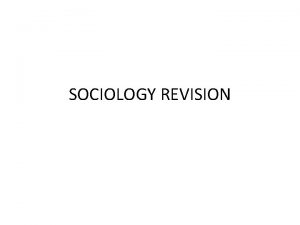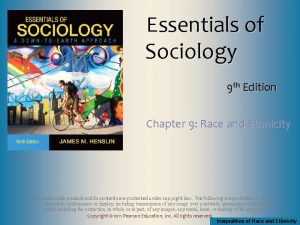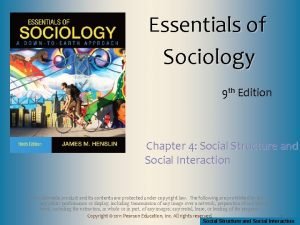Essentials of Sociology Thirteenth Edition Chapter 8 Social






















































- Slides: 54

Essentials of Sociology Thirteenth Edition Chapter 8 Social Class in the United States Copyright © 2019, 2017, 2014 Pearson Education, Inc. All Rights Reserved

Learning Objectives (1 of 3) 8. 1 Explain the three components of social class— property, power, and prestige; distinguish between wealth and income; explain how property and income are distributed; and describe the democratic façade, the power elite, and status inconsistency. 8. 2 Contrast Marx’s and Weber’s models of social class. Copyright © 2019, 2017, 2014 Pearson Education, Inc. All Rights Reserved

Learning Objectives (2 of 3) 8. 3 Summarize the consequences of social class for physical and mental health, family life, education, religion, politics, and the criminal justice system. 8. 4 Contrast the three types of social mobility, review gender issues in research on social mobility, and explain why social mobility brings pain. Copyright © 2019, 2017, 2014 Pearson Education, Inc. All Rights Reserved

Learning Objectives (3 of 3) 8. 5 Explain the problems in drawing the poverty line and how poverty is related to geography, race– ethnicity, education, feminization, and age. 8. 6 Contrast the dynamics of poverty with the culture of poverty, explain why people are poor and how deferred gratification is related to poverty, and comment on the Horatio Alger myth. 8. 7 Discuss the possibility that we are developing a three-tier society. Copyright © 2019, 2017, 2014 Pearson Education, Inc. All Rights Reserved

What is Social Class? 8. 1 Explain the three components of social class—property, power, and prestige; distinguish between wealth and income; explain how property and income are distributed; and describe the democratic façade, the power elite, and status inconsistency. • Property • Power • Prestige • Status Inconsistency Copyright © 2019, 2017, 2014 Pearson Education, Inc. All Rights Reserved

Property (1 of 4) • Distinguishing between wealth and income • Distribution of property • Distribution of income Copyright © 2019, 2017, 2014 Pearson Education, Inc. All Rights Reserved

Property (2 of 4) A mere one-half percent of Americans owns over a quarter of the entire nation’s wealth. Very few minorities are numbered among this 0. 5 percent. An exception is Oprah Winfrey, who has had an ultrasuccessful career in entertainment and investing. Worth $3. 0 billion, she is the 239 th richest person in the United States. Winfrey has given millions of dollars to help minority children. Copyright © 2019, 2017, 2014 Pearson Education, Inc. All Rights Reserved

Figure 8. 1 Distribution of the Wealth of Americans Pie charts showing the proportion of wealth in the U. S. owned by the wealthiest people. Source: By the author. Based on Wolff 2013. Copyright © 2019, 2017, 2014 Pearson Education, Inc. All Rights Reserved

Figure 8. 2 How the Income of Americans Is Distributed Graphic representation of the income differences in the U. S. Source: By the author. Based on Statistical Abstract of the United States 2017: Tables 705, 723. Copyright © 2019, 2017, 2014 Pearson Education, Inc. All Rights Reserved

Property (3 of 4) Table 8. 1 The Five Highest-Paid CEOs Name Company Compensation Marc Lore Walmart $237 million Tim Cook Apply $150 million John Weinberg Evercore Partners $124 million Sundar Pichai Alphabet $107 million Elon Musk Tesla $100 million Source: Melin 2017. Copyright © 2019, 2017, 2014 Pearson Education, Inc. All Rights Reserved

Figure 8. 3 The More Things Change, the More They Stay the Same: Dividing the Nation’s Income 1 Earliest year available. 2 No data for 1940. Source: By the author. Based on Statistical Abstract of the United States 1960: Table 417; 1970: Table 489; U. S. Census Bureau. Income, Poverty and Health Insurance Coverage in the United States: 2014. Historical Tables, Income, Households, Table H-2. 2016 ; Statistical Abstract of the United States 2017: Table 721. Copyright © 2019, 2017, 2014 Pearson Education, Inc. All Rights Reserved

Property (4 of 4) At 533 feet, the Eclipse is the world's second largest yacht. It is owned by Roman Abramovich of Russia, the world's 11 th richest person. Copyright © 2019, 2017, 2014 Pearson Education, Inc. All Rights Reserved

Power • The democratic façade • The power elite Copyright © 2019, 2017, 2014 Pearson Education, Inc. All Rights Reserved

Prestige (1 of 7) • Occupations and prestige • Displaying prestige Copyright © 2019, 2017, 2014 Pearson Education, Inc. All Rights Reserved

Prestige (2 of 7) Table 8. 2 Occupational Prestige: How the United States Compares with Sixty Countries Occupation United States Average of Sixty Countries Physician 86 78 Supreme Court judge 85 82 College president 81 86 Astronaut 80 80 Lawyer 75 73 College professor 74 78 Airline pilot 73 66 Architect 73 72 Biologist 73 69 Copyright © 2019, 2017, 2014 Pearson Education, Inc. All Rights Reserved

Prestige (3 of 7) Table 8. 2 Occupational Prestige: How the United States Compares with Sixty Countries Occupation United States Average of Sixty Countries Dentist 72 70 Civil engineer 69 70 Clergy 69 60 Psychologist 69 66 Pharmacist 68 64 High school teacher 66 64 Registered nurse 66 54 Professional athlete 65 48 Electrical engineer 64 65 Copyright © 2019, 2017, 2014 Pearson Education, Inc. All Rights Reserved

Prestige (4 of 7) Table 8. 2 Occupational Prestige: How the United States Compares with Sixty Countries Occupation United States Average of Sixty Countries Author 63 62 Banker 63 67 Veterinarian 62 61 Police officer 61 40 Sociologist 61 67 Journalist 60 55 Classical musician 59 56 Actor or actress 58 52 Chiropractor 57 62 Copyright © 2019, 2017, 2014 Pearson Education, Inc. All Rights Reserved

Prestige (5 of 7) Table 8. 2 Occupational Prestige: How the United States Compares with Sixty Countries Occupation United States Average of Sixty Countries Athletic coach 53 50 Social worker 52 56 Electrician 51 44 Undertaker 49 34 Jazz musician 48 38 Real estate agent 48 49 Mail carrier 47 33 Secretary 46 53 Plumber 45 34 Copyright © 2019, 2017, 2014 Pearson Education, Inc. All Rights Reserved

Prestige (6 of 7) Table 8. 2 Occupational Prestige: How the United States Compares with Sixty Countries Occupation United States Average of Sixty Countries Carpenter 43 37 Farmer 40 47 Barber 36 30 Store sales clerk 36 34 Truck driver 30 33 Cab driver 28 28 Garbage collector 28 13 Waiter or waitress 28 23 Bartender 25 23 Copyright © 2019, 2017, 2014 Pearson Education, Inc. All Rights Reserved

Prestige (7 of 7) Table 8. 2 Occupational Prestige: How the United States Compares with Sixty Countries Occupation United States Average of Sixty Countries Lives on public aid 25 16 Bill collector 24 27 Factory worker 24 29 Janitor 22 21 Shoe shiner 17 12 Street sweeper 11 13 NOTE: The rankings are based on 1 to 100, from lowest to highest. For five occupations not located in the 1994 source, the 1991 ratings were used: Supreme Court judge, astronaut, athletic coach, lives on public aid, and street sweeper. Sources: Treiman 1977: Appendices A and D; Nakao and Treas 1990, 1994: Appendix D. Copyright © 2019, 2017, 2014 Pearson Education, Inc. All Rights Reserved

Status Inconsistency (1 of 2) • Ranking higher on some dimensions of status than others – Lenski’s study – Gold’s study – A health issue Copyright © 2019, 2017, 2014 Pearson Education, Inc. All Rights Reserved

Status Inconsistency (2 of 2) Jesús Davila, winner of $265 million in the Illinois lottery, who is retired, used to drive cars for a living. How do you think his lottery win will change his life? Copyright © 2019, 2017, 2014 Pearson Education, Inc. All Rights Reserved

Sociological Models of Social Class (1 of 3) 8. 2 Contrast Marx’s and Weber’s models of social class. • Updating Marx • Updating Weber Copyright © 2019, 2017, 2014 Pearson Education, Inc. All Rights Reserved

Figure 8. 4 Marx’s Model of the Social Classes Source: By the author. Copyright © 2019, 2017, 2014 Pearson Education, Inc. All Rights Reserved

Figure 8. 5 Wright’s Modification of Marx’s Model of the Social Classes 1. Capitalists 2. Petty bourgeoisie 3. Managers 4. Workers Copyright © 2019, 2017, 2014 Pearson Education, Inc. All Rights Reserved

Figure 8. 6 The U. S. Social Class Ladder Source: By the author. Based on Gilbert and Kahl 1998 and Gilbert 2014; income estimates are inflation-adjusted and modified from Duff 1995. Copyright © 2019, 2017, 2014 Pearson Education, Inc. All Rights Reserved

Sociological Models of Social Class (2 of 3) The wealthiest person on the planet: Bill Gates, the cofounder of Microsoft, is worth $86 billion. He has also given away $30 billion, more than anyone in history. Copyright © 2019, 2017, 2014 Pearson Education, Inc. All Rights Reserved

Sociological Models of Social Class (3 of 3) Sociologists use income, education, and occupational prestige to measure social class. For most people, this works well, but not for everyone, especially entertainers. To what social class do these celebrities belong? Here is their net worth: Leonardo Di. Caprio $245 million, Taylor Swift $380 million, Dwayne Johnson $65 million, and Selena Gomez $54 million. Copyright © 2019, 2017, 2014 Pearson Education, Inc. All Rights Reserved

Consequences of Social Class (1 of 4) 8. 3 Summarize the consequences of social class for physical and mental health, family life, education, religion, politics, and the criminal justice system. • Physical Health • Mental Health • Family Life • Education • Religion • Politics • Crime and Criminal Justice Copyright © 2019, 2017, 2014 Pearson Education, Inc. All Rights Reserved

Figure 8. 7 Physical Health, by Income: People Who Have Difficulty with Everyday Physical Activities Bar graph showing the correlation between lower income and greater likelihood of physical difficulties. NOTE: In a national health survey, these people said they had difficulty walking, climbing steps, stooping, reaching overhead, grasping small objects, and carrying over 10 pounds. Source: By the author. Based on Schiller et al. 2012: Table 19. Copyright © 2019, 2017, 2014 Pearson Education, Inc. All Rights Reserved

Figure 8. 8 Mental Health, by Income: Feelings of Sadness, Hopelessness, or Worthlessness Bar graph showing the correlation between lower income and greater likelihood of emotional difficulties. NOTE: In a national health survey, these people answered “Always” or “Almost always” when they were asked how often they felt sad, hopeless, or worthless. Source: By the author. Based on Schiller et al. 2012: Table 14. Copyright © 2019, 2017, 2014 Pearson Education, Inc. All Rights Reserved

Consequences of Social Class (2 of 4) Among the customs of the rich, sometimes called the monied class, is ostentatious philanthropy. Shown here are women at the Frederick Law Olmsted lunch, a charity event in New York City. The women try to outdo one another with hats created for this event. Copyright © 2019, 2017, 2014 Pearson Education, Inc. All Rights Reserved

Consequences of Social Class (3 of 4) The disparities of social class in the United States are extreme. If you take the back roads in rural America, you will see thousands of trailers like this one in Davenport, Florida. Copyright © 2019, 2017, 2014 Pearson Education, Inc. All Rights Reserved

Consequences of Social Class (4 of 4) • Education – Type as well as amount of schooling • Religion – Type of denomination • Politics – Type of view on economic and social issues • Crime and Criminal Justice – Type as well as amount of consequences Copyright © 2019, 2017, 2014 Pearson Education, Inc. All Rights Reserved

Social Mobility (1 of 2) 8. 4 Contrast the three types of social mobility, review gender issues in research on social mobility, and explain why social mobility brings pain. • Three Types of Social Mobility – Intergenerational mobility – Structural mobility – Exchange mobility • Women in Studies of Social Mobility • The Pain of Social Mobility Copyright © 2019, 2017, 2014 Pearson Education, Inc. All Rights Reserved

Figure 8. 9 Income of Adult Children Compared with that of Their Parents Source: Pursuing the American Dream: Economic Mobility Across Generations, p. 6. © July, 2013 the Pew Charitable Trusts. Copyright © 2019, 2017, 2014 Pearson Education, Inc. All Rights Reserved

Social Mobility (2 of 2) Both downward and upward social mobility bring challenges that require life adjustments. An extreme instance is the case of Sly Stone, the front man of the 1970 s funk band, Sly and the Family Stone. His saga includes going from wealth of millions to living in a van. Copyright © 2019, 2017, 2014 Pearson Education, Inc. All Rights Reserved

Poverty 8. 5 Explain the problems in drawing the poverty line and how poverty is related to geography, race–ethnicity, education, feminization, and age. • Drawing the Poverty Line • Who Are the Poor? • Children of Poverty Copyright © 2019, 2017, 2014 Pearson Education, Inc. All Rights Reserved

Drawing the Poverty Line • Arbitrary line • Official measure of poverty Copyright © 2019, 2017, 2014 Pearson Education, Inc. All Rights Reserved

Who Are the Poor? • The geography of poverty • Race–ethnicity • Education • The feminization of poverty • Old age Copyright © 2019, 2017, 2014 Pearson Education, Inc. All Rights Reserved

Figure 8. 10 An Overview of Poverty in the United States Pie chart showing the proportion of the poor who are in the various racial-ethnic groups. Source: By the author. Based on Statistical Abstract of the United States 2017: Table 35. Copyright © 2019, 2017, 2014 Pearson Education, Inc. All Rights Reserved

Figure 8. 11 Patterns of Poverty U. S. map showing state-by-state percentages of those in poverty. Source: By the author. Based on Statistical Abstract of the United States 2017: Table 734. Copyright © 2019, 2017, 2014 Pearson Education, Inc. All Rights Reserved

Figure 8. 12 Who Ends Up Poor? Poverty by Education and Race–Ethnicity Source: By the author. Based on U. S. Census Bureau 2016 b: Table POV 29. Copyright © 2019, 2017, 2014 Pearson Education, Inc. All Rights Reserved

Figure 8. 13 Poverty and Family Structure Bar graph showing the greater likelihood of poverty for female-headed families. Source: By the author. Based on Statistical Abstract of the United States 2017: Table 741. Copyright © 2019, 2017, 2014 Pearson Education, Inc. All Rights Reserved

Figure 8. 14 Poverty and Race-Ethnicity Bar graph demonstrating the disproportionate likelihood for Latinos and African Americans to be poor. Source: By the author. Based on Statistical Abstract of the United States 2017: Table 738. Copyright © 2019, 2017, 2014 Pearson Education, Inc. All Rights Reserved

Figure 8. 15 Poverty, Age, and Race-Ethnicity Bar graph demonstrating the greater likelihood of some racial-ethnic groups’ youth and/or elderly to be in poverty than others. NOTE: Only these groups are listed in the source. The poverty line is $24, 230 for a family of four. Source: By the author. Based on Statistical Abstract of the United States 2017: Tables 35, 738. Copyright © 2019, 2017, 2014 Pearson Education, Inc. All Rights Reserved

Figure 8. 16 How Does Education Influence Births to Single Women Bar graph showing the correlation between higher levels of education and lower percentages of births to single women. Source: Shuttuck and Kreider 2013: Table 2. Copyright © 2019, 2017, 2014 Pearson Education, Inc. All Rights Reserved

Figure 8. 17 How Does Income Influence Births to Single Women Bar graph showing the correlation between higher incomes and lower percentages of births to single women. Source: Shuttuck and Kreider 2013: Table 2 Copyright © 2019, 2017, 2014 Pearson Education, Inc. All Rights Reserved

Children of Poverty • Children are more likely to be poor – Especially when Latino or African American – Especially when compared with the elderly Copyright © 2019, 2017, 2014 Pearson Education, Inc. All Rights Reserved

The Dynamics of Poverty Versus the Culture of Poverty 8. 6 Contrast the dynamics of poverty with the culture of poverty, explain why people are poor and how deferred gratification is related to poverty, and comment on the Horatio Alger myth. • Why Are People Poor? • Deferred Gratification • Where is Horatio Alger? – The social functions of a myth Copyright © 2019, 2017, 2014 Pearson Education, Inc. All Rights Reserved

Why Are People Poor? • Social structure • Characteristics of individuals • Poverty triggers Copyright © 2019, 2017, 2014 Pearson Education, Inc. All Rights Reserved

Deferred Gratification • Behaviors of the poor – Cause or result of poverty? Copyright © 2019, 2017, 2014 Pearson Education, Inc. All Rights Reserved

Where is Horatio Alger? The Social Functions of a Myth • Encourages people to strive to get ahead • Blames individuals for their failures Copyright © 2019, 2017, 2014 Pearson Education, Inc. All Rights Reserved

Peering into the Future: Will We Live in a Three-Tier Society? 8. 7 Discuss the possibility that we are developing a three-tier society. • Three Tiers – Wealthy – Technically trained – Jobless poor • Two “Solutions” to Defer Upheaval – Pacification – Militarization of police Copyright © 2019, 2017, 2014 Pearson Education, Inc. All Rights Reserved
 Essentials of sociology 5th edition
Essentials of sociology 5th edition Business essentials 12th edition
Business essentials 12th edition Essentials of sociology a down-to-earth approach
Essentials of sociology a down-to-earth approach William stallings network security essentials 5th edition
William stallings network security essentials 5th edition Essentials of investments 11th edition
Essentials of investments 11th edition Understanding business 12th edition chapter 1
Understanding business 12th edition chapter 1 Firefighter essentials 7th edition
Firefighter essentials 7th edition Business essentials 12th edition
Business essentials 12th edition Essentials of management information systems
Essentials of management information systems Essentials of organizational behavior 14th edition
Essentials of organizational behavior 14th edition Essentials of firefighting 7th edition
Essentials of firefighting 7th edition Cryptographic systems are generically classified by
Cryptographic systems are generically classified by Nonintervention perspective of criminal justice
Nonintervention perspective of criminal justice Essentials of social media marketing chapter 9 quiz
Essentials of social media marketing chapter 9 quiz Introduction to sociology 9th edition
Introduction to sociology 9th edition Sociology in modules 4th edition
Sociology in modules 4th edition Sociology, 16th edition
Sociology, 16th edition Primary and secondary deviance
Primary and secondary deviance Using mis (10th edition) 10th edition
Using mis (10th edition) 10th edition Report
Report Social change in social work
Social change in social work Sociology understanding and changing the social world
Sociology understanding and changing the social world Social change in sociology
Social change in sociology Sociology vs social psychology
Sociology vs social psychology What is a social movement sociology
What is a social movement sociology Social institutions meaning sociology
Social institutions meaning sociology Definition of stratification
Definition of stratification Classification of social group
Classification of social group Sociology as social science
Sociology as social science Social structure definition sociology
Social structure definition sociology Sociology vs social psychology
Sociology vs social psychology Factors of social change sociology
Factors of social change sociology Sociology relation with other social sciences
Sociology relation with other social sciences What is a social movement sociology
What is a social movement sociology Types of social groups in sociology
Types of social groups in sociology Social mobility definition sociology
Social mobility definition sociology Dimensions of social class
Dimensions of social class Social psychology and common sense
Social psychology and common sense Sociology social groups
Sociology social groups Social process that gets things done
Social process that gets things done Social inequality examples
Social inequality examples Durkheim anomie
Durkheim anomie Distinguishing characteristics of social work
Distinguishing characteristics of social work What is social action
What is social action Identify the examples of interactional vandalism.
Identify the examples of interactional vandalism. Social control theory definition
Social control theory definition Internal social control examples
Internal social control examples Social control introduction
Social control introduction Sociology: understanding and changing the social world
Sociology: understanding and changing the social world Social thinking adalah
Social thinking adalah Social thinking social influence social relations
Social thinking social influence social relations It essentials chapter 8
It essentials chapter 8 5 essentials for a successful ffa chapter
5 essentials for a successful ffa chapter It essentials chapter 9
It essentials chapter 9 It essential chapter 14
It essential chapter 14
